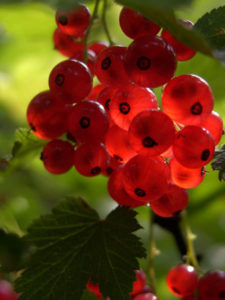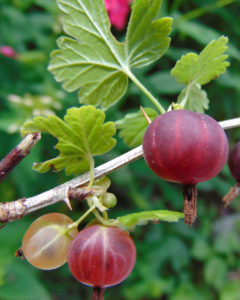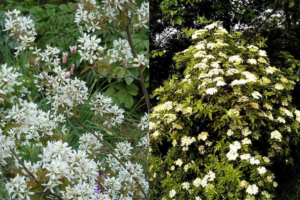Berries are my favorite addition to the production garden – they are the perfect topping for ice cream and yogurt and make delicious pies! But they can be expensive to source from the grocery store and certain types are nearly impossible to find. Why not grow your own? Many types of raspberries, strawberries, gooseberries and currants are adaptable to Kansas, flourishing under the right conditions. If you don’t have space to create a vegetable garden, no worries – berry plants can mix into the perennial borders and become a productive (and delicious!) part of your landscape for you and for the wildlife.
Raspberries
Rubus idaeus, red raspberries, got their initialized name from Mt. Ida in Turkey, where the citizens of ancient Troy dined on them. Since that time they have spread throughout the world because of their sweetness and adaptability. These delicious little morsels do not naturally flourish in the harsh Kansas climate, but with a little human attention they can produce a summer full of fruit for you.

Wild red raspberries. Photo by mako from Kangasala, Suomi (Finland) (wild raspberries) [CC BY 2.0], via Wikimedia Commons
Currants and Gooseberries
Currants and gooseberries are part of the Ribes genus, some of which are native to Kansas. Ribes ordoratum (golden currant) is commonly found in thickets and near streams, bearing delicious wild fruit great for canning. These wild types can be grown in the landscape for their berries, wildlife appeal and ornamental value. I discovered cultivated red currants while traveling in France; they are a staple of a French breakfast table, irresistible in jams and sauces. ‘Red Lake’ is a type that grows well here in Kansas, with bountiful bunches of marble-sized red berries. Plant in neutral pH soil and don’t keep their feet wet for extended periods of time.

Red currants ripe for the piking! Photo by Idalia Skalska (http://idalia.pl/) [CC BY-SA 3.0], via Wikimedia Commons

The greenish-pink gooseberries sport characteristic veins/stripes and a sour taste. Photo by Nadiatalent (Own work) [CC BY-SA 4.0], via Wikimedia Commons
Strawberries
Everybody’s favorite mid-summer treat, strawberries, are easy to establish and spread via runners to increase yields year after year. A raised bed is a common way to grow strawberries, helping with weed management and containment. A layer of straw or mulch around new plants will aide in retaining soil moisture. If you have no room for a raised bed area, don’t fret! Strawberries are happy to live in the perennial garden and crawl around the bases of taller plants – they will behave as a ground cover (suppressing weeds!) and benefit from the light shade cast by the flowers above them. Some varieties are bred specifically to grow in a patio pot and produce vigorously. ‘Tristan’ and ‘Ruby Ann’ are examples of this type. They always provide me with a midday snack in the greenhouse!

Serviceberry (left) and Elderberry (right) in bloom. From https://commons.wikimedia.org/wiki/File:Sambucus_nigra-Busch.jpg and By peganum from Small Dole, England (Amelanchier x grandiflora Cole’s Select) [CC BY-SA 2.0], via Wikimedia Commons
Elderberries, Chokeberries, Serviceberries
Lesser known or wild-type berries are just as nutritious, but require less maintenance. These berries all taste best after some type of processing (cooking, freezing, juicing, etc). All three of the following berry-producers bear stunning white blooms and produce fruit with high nutritional content for your table or for the birds to enjoy!
- Consider planting elderberry (Sambucus) shrubs in a drainage area or part of the yard that always floods – they will absorb excess water and create a wall of blooms in late spring. Raw elderberries are bitter, but perform well in jams, wines, and home remedies. ‘Adams’ and ‘York’ are two types of elderberry we recommend for heavy fruit production.
- Chokeberry (Aronia melanocarpa) is a versatile and attractive shrub that bears high-antioxidant blackish berries in late summer. The berries have an astringent quality that makes the mouth pucker with that ‘dry wine’ feeling. Berries can be made into syrups and jams, or used in muffins. Five to six feet tall at maturity, they make a great screen or windbreak. Aronia ‘Viking’ is a nice variety that produces well and has high ornamental value. ‘Low Scape’ and ‘Hedger’ types for smaller spaces display blooms and attractive fall foliage but do not produce much fruit.
- Serviceberry (Amelanchier arborea) is native to the eastern-most regions of Kansas and can reach 20 feet tall in some locations. It makes an excellent specimen tree and produces fruit that taste much like blueberries. The berries ripen in mid-summer, earlier than most other berries. They can be eaten right off the tree, baked into pies or dried like raisins for preserving.
Growing berries can be fun and easy! Consider planting some edibles in your landscape as a part of your hedge or as a perennial ground cover. They will look great and taste even better. If you don’t have time to pick them for yourself, the wildlife will thank you for the extra sweet treat!
